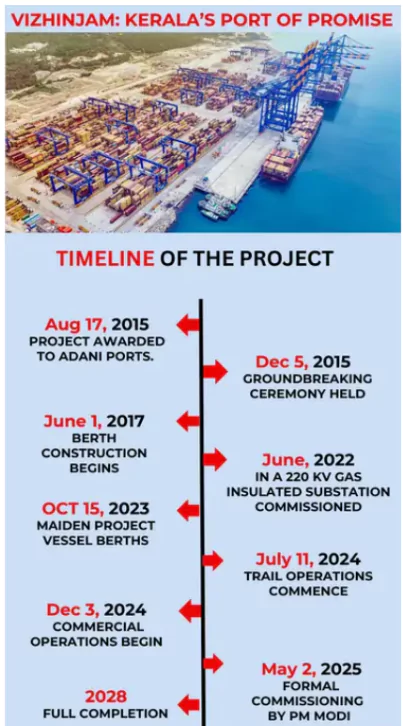Core Demand of the Question
- Discuss the importance of Vizhinjam International Transhipment Deepwater Multipurpose Seaport.
- Evaluate how mega port projects can transform India’s logistics sector.
- Evaluate how mega port projects can transform trade competitiveness.
|
Answer
The Vizhinjam International Transhipment Deepwater Multipurpose Seaport, developed under a PPP model by Adani Ports and the Kerala government, marks a strategic shift in India’s maritime economy. Its location, automation, and deep draft make it central to boosting logistics and trade competitiveness.

Importance of Vizhinjam Seaport
- Strategic Location Advantage: Located just 10 nautical miles from major global shipping lanes, it enhances India’s access to Europe, West Asia, and Far East routes.
Example: Its proximity to key maritime routes enables ultra-large vessels to dock without deviation, cutting shipping costs.
- Reducing Foreign Dependency: Handles cargo domestically, cutting dependence on ports like Colombo and Singapore.
- Deep Natural Draft Efficiency: With a natural draft of ~20 metres, it minimizes dredging costs and accommodates larger vessels.
Example: No major capital dredging is needed, enabling faster, cost-effective berthing of mother vessels.
- Technological Modernization: India’s first semi-automated port with AI-based traffic management improves speed and reliability.
Example: Features remote-controlled quay cranes and an AI-powered VTMS, ensuring faster vessel turnaround and real-time updates.
- PPP Investment Model: Joint investment ensures shared accountability and financial sustainability.
Example: Phase-I funding includes ₹5,595 crore from Kerala, ₹2,454 crore by Adani Ports, and ₹818 crore as central viability gap fund.
How Mega Port Projects Can Transform Logistics
- Efficient Container Handling: Ports like Vizhinjam cut delays and streamline cargo movement.
Example: 265 ships, including mother vessels, berthed since July 2024, demonstrating operational success.
- Improved Hinterland Connectivity: Integration with rail and road systems improves cargo distribution inland.
Example: Completion of connectivity infrastructure is vital to accessing South India’s hinterland and improving freight flow.
- Cost Reduction in Logistics: Better port efficiency reduces overall transport and warehousing costs.
- Boost to Coastal Shipping: Mega ports act as coastal hubs, reviving short-sea shipping networks.
- Incentivizing Port-led Development: Mega ports drive warehousing, logistics parks, and industrial growth.
Example: Vizhinjam’s next phase of ₹9,500 crore investment by 2028 includes support infrastructure, enabling multimodal development.
How Mega Ports Can Boost Trade Competitiveness
- Lower Turnaround Time: Reduces ship waiting and increases frequency of trade movements.
Example: Vizhinjam’s AI-powered control room optimizes vessel scheduling and cuts port stay duration.
- Improved Export Potential: Faster cargo handling encourages manufacturers to export more.
- Enhanced Global Standing: Reduces reliance on foreign ports and boosts India’s position in maritime trade.
Example: Diverting cargo from Colombo, Salalah, and Dubai enhances India’s transshipment profile.
- Attracting FDI in Maritime Sector: Advanced port models attract global investors and private players.
Example: The DBFOT model used at Vizhinjam shows investor confidence in India’s maritime infrastructure.
- Strengthened Supply Chains: Reliable ports make supply chains resilient to global disruptions.
The Vizhinjam Seaport embodies India’s ambition to be a self-reliant maritime hub, reducing external dependence and enabling logistics and trade transformation. Timely execution of future phases and multimodal support infrastructure will be crucial to maximize its national and regional impact.
To get PDF version, Please click on "Print PDF" button.


Latest Comments